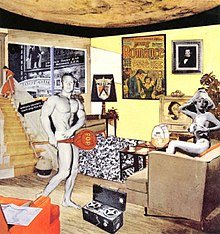Photomontage[edit]
Main article: Photomontage
Collage made from photographs, or parts of photographs, is called photomontage. Photomontage is the process (and result) of making a composite photograph by cutting and joining a number of other photographs. The composite picture was sometimes photographed so that the final image is converted back into a seamless photographic print. The same method is accomplished today using image-editing software. The technique is referred to by professionals as compositing.
Richard Hamilton, John McHale, Just What Is It That Makes Today’s Homes So Different, So Appealing? 1956, collage, (one of the earliest works to be considered Pop Art)
Other methods for combining pictures are also called photomontage, such as Victorian "combination printing", the printing from more than one negative on a single piece of printing paper (e.g. O. G. Rejlander, 1857), front-projection and computer montage techniques. Much as a collage is composed of multiple facets, artists also combine montage techniques. Romare Bearden’s (1912–1988) series of black and white "photomontage projections" is an example. His method began with compositions of paper, paint, and photographs put on boards 8½ × 11 inches. Bearden fixed the imagery with an emulsion that he then applied with handroller. Subsequently, he enlarged the collages photographically.
The 19th century tradition of physically joining multiple images into a composite and photographing the results prevailed in press photography and offset lithography until the widespread use of digital image editing. Contemporary photo editors in magazines now create "paste-ups" digitally.
Creating a photomontage has, for the most part, become easier with the advent of computer software such as Adobe Photoshop, Pixel image editor, and GIMP. These programs make the changes digitally, allowing for faster workflow and more precise results. They also mitigate mistakes by allowing the artist to "undo" errors. Yet some artists are pushing the boundaries of digital image editing to create extremely time-intensive compositions that rival the demands of the traditional arts. The current trend is to create pictures that combine painting, theatre, illustration and graphics in a seamless photographic whole.
No comments:
Post a Comment